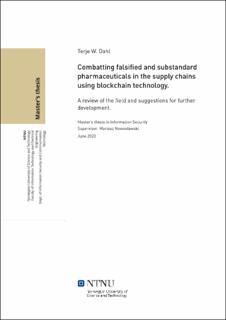| dc.contributor.advisor | Nowostawski, Mariusz | |
| dc.contributor.author | Dahl, Terje W. | |
| dc.date.accessioned | 2021-09-23T19:06:00Z | |
| dc.date.available | 2021-09-23T19:06:00Z | |
| dc.date.issued | 2020 | |
| dc.identifier | no.ntnu:inspera:56390147:26325167 | |
| dc.identifier.uri | https://hdl.handle.net/11250/2781125 | |
| dc.description.abstract | Verdens Helseorganisasjon (WHO) har rapportert falske og substandard legemidler i forsyningskjedene i de fleste regioner i verden. Til tross for reguleringer og forbedret teknologi fortsetter dette problemet å representere en alvorlig helsetrussel. Den relativt nye blokkjede-teknologien har blitt foreslått brukt for å bekjempe denne trusselen. Denne oppgaven utforsker problemet ved å sammenfatte forskningen på blokkjedebasert bekjempelse av falske og substandard legemidler i forsyningskjeden. I tillegg forsøker den å integrere forskningsresultater og teori fra relevante disipliner med tanke på å kunne gi råd til utviklere og forskere i feltet.
Det er gjort et litteratursøk ved hjelp av Scopus for å samle relevante publikasjoner. Resultatene har blitt beskrevet og analysert i lys av blokkjede-teori, forsyningskjede teori og forskningsresultater fra nærliggende felt. Feltet er lite i volum, teoretisk eller konseptuelt i natur og mangler modenhet. ‘Private and permissioned’ blokkjede-arkitektur dominerer. Den mangfoldige og globale legemiddelindustrien indikerer videre forskning på interoperabilitet mellom forskjellige blokkjeder. Det er ingen klare anbefalinger for en konsensus mekanisme som passer best til problemområdet. Likevel anbefales nøye vurdering av egenskapene til de forskjellige
konsensusmekanismene. Utviklere som planlegger å bygge prototyper eller reelle implementasjoner i dette feltet anbefales å gå gjennom rammeverk med klare kriterier for å vurdere om blokkjede-teknologi er best egnet. | |
| dc.description.abstract | The World Health Organization has reported falsified and substandard pharmaceuticals in the supply chains in most regions in the world. Despite regulations and improved anti-counterfeit technology, this problem continues to represent a serious threat to public health. The relatively new blockchain technology has been proposed as a factor that can help counter this threat. This thesis explores the problem by reviewing the research field of using blockchain technology to combat falsified and substandard pharmaceuticals in the supply chain. Additionally, it tries to integrate research results and theory from relevant disciplines to make suggestions to developers and researchers in the field.
A literature search using the Scopus search system was conducted to collect relevant papers. The results were described and analysed using theory of blockchain technology, supply chain management and research results from allied research fields. The research in the field is small in volume, theoretical or conceptual in nature and lack maturity. Private and permissioned blockchain architectures are dominating. The diverse and global pharmaceutical industry suggests further research into interoperability between blockchains. There are no clear suggestions for a consensus mechanism that fits the problem best, although careful consideration of the characteristics of different consensus mechanisms are recommended. Developers planning to build prototypes or real-world implementations in this field should use frameworks with well-defined criteria before they decide if blockchain technology is the best option. | |
| dc.language | | |
| dc.publisher | NTNU | |
| dc.title | Combatting falsified and substandard pharmaceuticals in the supply chains using blockchain technology.
A review of the field and suggestions for further development | |
| dc.type | Master thesis | |
